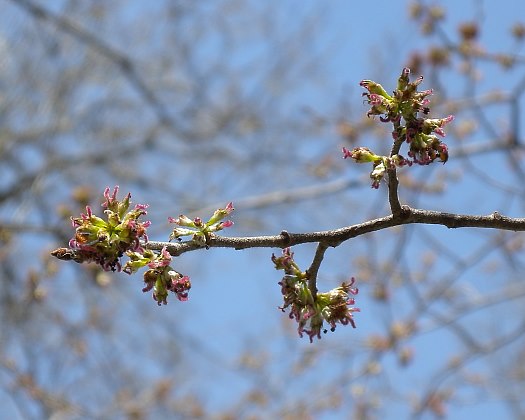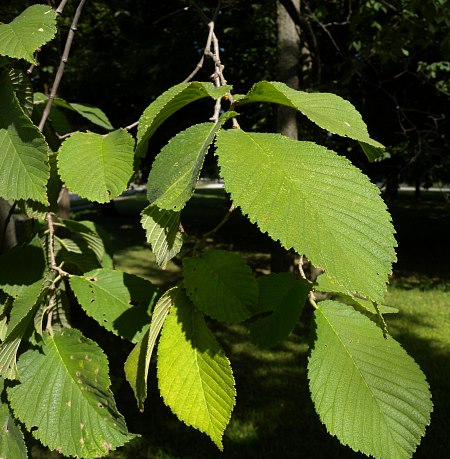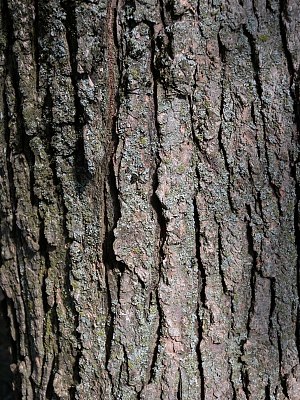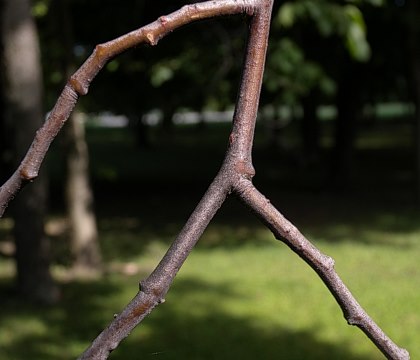Description: This tree is 40-80' tall (rarely taller) at maturity, forming a single trunk about 1-3' across and an ovoid crown that is sometimes flat-topped. The branches are ascending to widely spreading, becoming subdivided into numerous twigs. Trunk bark is predominantly gray, consisting of narrow flat ridges and shallow furrows; inner bark is more reddish brown, as revealed by some of the furrows. The bark of branches and older twigs are more smooth and gray to reddish brown, while the bark of young twigs is reddish brown and hairy. Winter buds at the tips of twigs are brown with reddish hairs. Alternate leaves are 4-6" long and 2-3" across; they are ovate to slightly obovate and doubly serrate along their margins. Leaf venation is pinnate with a central vein and about 12-15 parallel lateral veins. At least 4 lateral veins on each side of the central vein are forked. The upper leaf surface is dull medium green and rough-textured from stiff minute hairs. The lower leaf surface is whitish green and more or less covered with short pubescence. The white ribs of the veins are very prominent along the lower surface. The petioles are about ¼-½" long, light green, and short-pubescent. The leaves are arranged along each twig in two ranks.

The greenish red flowers of Slippery Elm are unisexual or perfect (usually the latter); they are arranged in dense clusters of 5-20 flowers up to 1" across on short pedicels about 1/8" (3 mm.) long. Male, female, and perfect flowers have a short tubular calyx with 5-9 oblong lobes. The calyx is green and hairy; its lobes are erect. Male flowers have 5-9 stamens with reddish anthers, while female flowers have a pistil with a pair of stigmata that are plumose and pinkish red; perfect flowers have both stamens and a pistil. The blooming period occurs from early to mid-spring before the leaves develop; the flowers are wind-pollinated. Fertile female or perfect flowers are replaced by samaras about ½-¾" across. Individual samaras are ovate to orbicular and flattened, consisting of a central seed body that is surrounded by a wide membranous wing. The membranous wings of the samaras are glabrous, while the central seed bodies are hairy. Each samara has a cleft tip that is only slightly notched. The samaras become tan at maturity; they are distributed by the wind during late spring as the leaves develop. The root system is woody and widely spreading. The deciduous leaves usually become dull yellow during the fall.

Cultivation: Slippery Elm prefers full sun to medium shade, moist to mesic conditions, and soil containing loam or clay-loam. It is somewhat vulnerable to Dutch Elm disease, although less so than American Elm (Ulmus americana). Growth and development are moderately fast. While individual trees can live up to 200 years, average life expectancy is shorter than this because of Dutch Elm and other disease organisms.
Range & Habitat: The native Slippery Elm is common in Illinois, occurring in every county (see Distribution Map). Habitats include rich mesic woodlands, floodplain woodlands, the lower slopes of wooded bluffs, rocky upland woodlands, shaded gravelly seeps, riverbanks, edges of limestone glades, thickets, and disturbed areas along railroads and roadways. In dense deciduous woodlands, Slippery Elm exists primarily as an understory tree. It benefits from disturbance that reduces competition from dominant canopy trees.

Faunal Associations: Like other elms (Ulmus spp.), Slippery Elm attracts many kinds of insects that feed on its wood, bark, leaves, sap, etc. These insect feeders include the larvae of wood-boring beetles, larvae of bark beetles, leaf beetles, weevils, plant bugs, stink bugs, aphids, leafhoppers, treehoppers, mealy bugs, armored scales, walkingsticks, larvae of a variety of sawflies, larvae of a variety of moths, and larvae of the following butterflies: Mourning Cloak (Nymphalis antiopa), Comma (Polygonia comma), and Question Mark (Polygonia interrogationis). The Insect Table provides a more detailed list of these species. Many species of birds eat the seeds, buds, and/or florets of these trees; this includes the Wood Duck, Northern Cardinal, Rose-breasted Grosbeak, Evening Grosbeak, Common Redpoll, Purple Finch, Pine Siskin, American Goldfinch, House Sparrow, Clay-colored Sparrow, Black-capped Chickadee, Carolina Chickadee, Yellow-rumped Warbler, Bobwhite Quail, Ruffed Grouse, Wild Turkey, Ring-necked Pheasant, and Greater Prairie Chicken. In addition, the sap of this tree is consumed by the Yellow-bellied Sapsucker (DeGraaf, 2002; Schwartz, 1945; Martin et al., 1951/1961; DeVore et al., 2004). Mammals also feed on various parts of Slippery Elm and other elm trees, including the American Beaver (bark, wood), White-tailed Deer (twigs), Cottontail Rabbit (bark of saplings), Eastern Gray Squirrel (seeds), and Fox Squirrel (seeds, buds, florets); see Martin et al. (1951/1961).

Photographic Location: A wooded area at Chief Shemauger Park in Urbana, Illinois.
Comments: With the decline of American Elm (Ulmus americana) in Illinois, Slippery Elm is now the most commonly encountered tree in its genus. It can be distinguished from other elms (Ulmus spp.) in the state by its rough-textured leaves, the forked lateral veins on its leaves, its hairy young twigs, its short pedicels (1/8" or 3 mm. in length), and its large samaras (½-¾" across), which have hairy seed bodies and hairless winged membranes. The common name of this tree is derived from its mucilaginous inner bark. Another common is Red Elm.